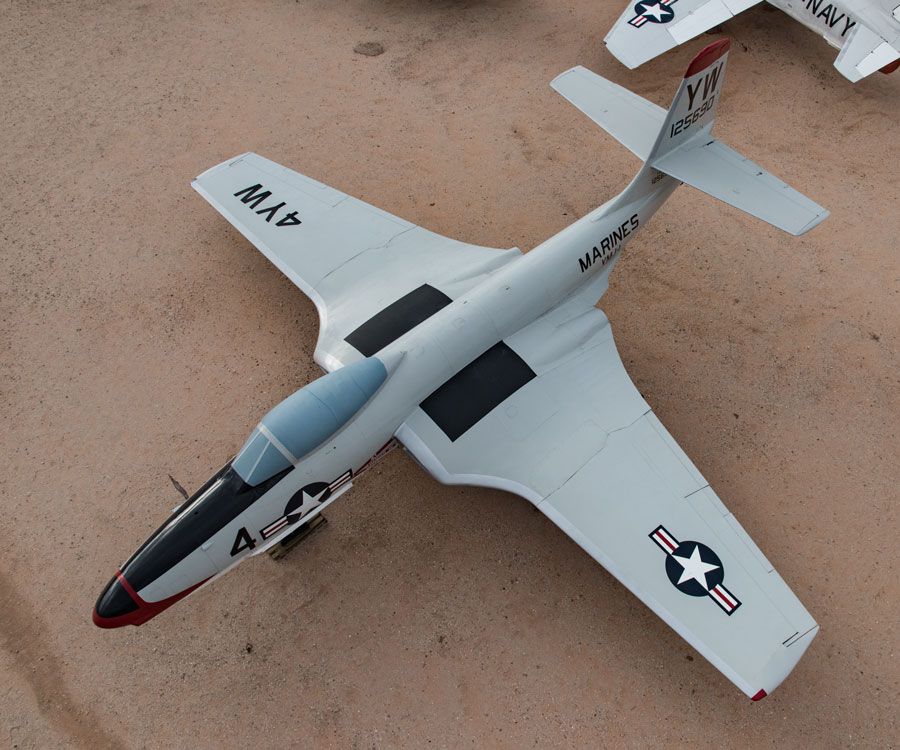McDonnell F2H-2P
McDonnell F2H-2P Banshee

The Banshee was developed as an enlarged version of the McDonnell FH-1 Phantom. The aircraft featured more powerful engines and greater armament than the earlier aircraft. The F2H-1 prototype first flew on January 11, 1947 and operational aircraft reached service in March 1949. By the end of 1949 the F2H-2 version of the aircraft was in service. It featured a longer fuselage and wings which allowed more fuel to be carried, increasing the plane’s range. The F2H-3 and F2H-4 featured an even longer fuselage and more fuel as well as a search radar making them all-weather and night capable. The F2H-2 was also modified into a photo reconnaissance version with a lengthened nose housing several cameras. The Banshee was used extensively during the Korean War as both a fighter and a reconnaissance plane. Banshees were also sold to Canada and served in the Canadian Navy from 1955 until 1962. The last Banshees left the U.S. Navy’s inventory in 1965.
Service History:
| Wingspan | 44 ft 10 in. |
Wingspan |
| Length | 40 ft 2 in. |
Length |
| Height | 14 ft 6 in. |
Height |
| Weight | 22,312 pounds (loaded) |
Weight |
| Max. Speed | 532 MPH |
Maximum Speed |
| Service Ceiling | 44,800 feet |
Service Ceiling |
| Range | 1,475 miles |
Range |
| Engines | Two Westinghouse J34-WE-34 turbojets with 3,250 pounds of thrust each |
Engines |
| Crew | 1 |
Crew |
Manufacturer
McDonnell
Markings
Marine Photographic Reconnaissance Squadron 2 (VMJ-2), Marine Corps Air Station Atsugi, Japan, 1958
Designation
F2H-2P
Serial Number
125690
Built by McDonnell Aircraft at St. Louis, Missouri and delivered to the U.S. Navy on October 12, 1951.
October 1951 To Bureau of Aeronautics Representative, Research & Development, St. Louis, Missouri.
June 1952 To Naval Air Test Center, Naval Air Station Patuxent River, Maryland.
March 1953 To Composite Squadron 61 (VC-61), Naval Air Station Miramar, California.
March 1954 To Overhaul & Repair, San Diego, California.
April 1954 To Overhaul & Repair, Jacksonville, Florida.
October 1954 To Composite Squadron 62 (VC-62) Naval Air Station Jacksonville, Florida. Deployed on USS Bennington, USS Intrepid, and USS Forrestal.
September 1956 To Overhaul & Repair, Marine Corps Air Station Cherry Point, North Carolina.
April 1957 To Reconnaissance Squadron 61 (VFP-61), Naval Air Station Alameda, California.
December 1957 To Fleet Aircraft Service Squadron 3 (FASRON-3) Naval Air Station Alameda, California.
February 1958 To Marine Photographic Reconnaissance Squadron 1 (VMJ-1), Marione Corps Air Station Atsugi, Japan.
June 1958 To Naval Air Facility Advanced Base at Oppama, Japan.
October 1958 To Fleet Aircraft Service Squadron 4 (FASRON 4), Naval Air Station North Island, California.
October 1958 To Storage at Litchfield Park, Arizona.
1958-2012 Displayed at St. Louis, Missouri; Cherry Point, North Carolina; and Wings of Eagles Museum, New York. At some point the aircraft’s original photoreconnaissance nose was replaced with the gun equipped nose of a standard Banshee fighter.
2012 Loaned to the Pima Air and Space Museum by the National Museum of the Marine Corps.
